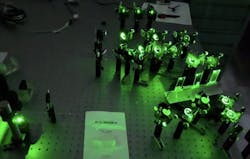Linear optical sensor could achieve Heisenberg-limited sensitivity
Researchers from the Moscow Institute of Physics and Technology (MIPT; Russia) and the Argonne National Laboratory (ANL; Argonne, IL) have taken an advanced quantum algorithm for measuring physical quantities called the unitary Fourier transform and implemented it for measuring physical quantities using simple optical tools. Their study may lead to affordable linear-optics-based sensors with higher performance characteristics. Until recently, no measurement tool could ensure precision above the so-called shot-noise limit, related to the statistical features inherent in classical observations. Quantum technology has provided a way around this, boosting precision to the fundamental Heisenberg limit stemming from the basic principles of quantum mechanics. For example, the Laser Interferometer Gravitational-wave Observatory (LIGO) experiment, which detected gravitational waves for the first time in 2016, shows it is possible to achieve Heisenberg-limited sensitivity—for example, for phase estimation—by combining complex optical interference schemes and quantum techniques.
To fuse quantum metrology with linear optics, the team from MIPT and ANL put together a specific arrangement consisting of a very large number of linear optical elements (conventional beamsplitters, phase shifters, mirrors, and so on) that can make it possible to gain information about the geometric angles, positions, velocities, and other parameters of physical objects. The measurement involves encoding the "quantity of interest" in the optical phases, which are then determined directly (the photo by Nikita Kirsanov of MIPT shows an apparatus for measuring the position of an object using optical coherence alone).
Despite the large number of optical elements in the scheme, it is nevertheless tunable and controllable, say the researchers. According to the theoretical estimates provided in the paper, linear optics tools are viable for implementing even operations that are considerably more complex. “The study has demonstrated that linear optics offers an affordable and effective platform for implementing moderate-scale quantum measurements and computations,” says ANL researcher Valerii Vinokur. Reference: V. V. Zemlyanov et al., Sci. Rep. (2020); https://doi.org/10.1038/s41598-020-65466-3.
About the Author
John Wallace
Senior Technical Editor (1998-2022)
John Wallace was with Laser Focus World for nearly 25 years, retiring in late June 2022. He obtained a bachelor's degree in mechanical engineering and physics at Rutgers University and a master's in optical engineering at the University of Rochester. Before becoming an editor, John worked as an engineer at RCA, Exxon, Eastman Kodak, and GCA Corporation.

